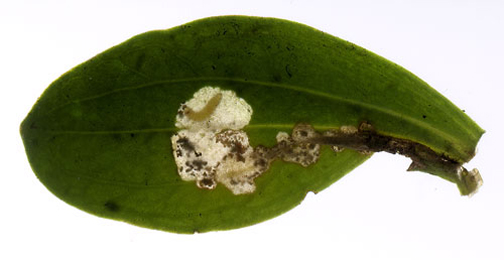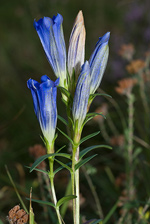|
||||||
|
GENTIANA. Gentians. [Gentianaceae] |
|
|
Seven species of Gentiana are recorded in Britain. These include the native Alpine Gentian (G. nivalis), Marsh Gentian (G. pneumonanthe) and Spring Gentian (G. verna). Alpine Gentian (G. nivalis) and Spring Gentian (G. verna) are protected under Schedule 8 of the Wildlife and Countryside Act, 1981. Three British miners are recorded on Gentiana. Elsewhere the agromyzids Liriomyza bryoniae and Liriomyza huidobrensis are recorded mining Gentiana. See also Liriomyza species in Glasshouses and/or Quarantine Interceptions. A key to the European miners recorded on Gentiana is provided in Bladmineerders van Europa. |
|
|
Key for the identification of the known mines of British |
1a > Leaf-miner: Mine linear in first instar, later developing into a blotch which is frequently at base of leaf. Pupation internal (Spencer, 1990: 397). The mine starts as a gallery, but this is engulfed by the upper surface blotch that eventually forms. This mine is in a basal leaf - right on the ground amongst the grasses etc. The mine is usually in basal part of leaf. The larva pupariates in the mine and the spiracles protrude through the upper epidermis. |
|
Chromatomyia centaurii Spencer, 1990 [Diptera: Agromyzidae]. |
1b > Leaf-miner: Initially the larva mines a basal leaf, subsequently feeding in flower buds (which turn yellow), opened flowers and foliage. Full depth irregular blotch that may occupy an entire leaf. Frass in numerous, dispersed, brown grains. Some larvae remain in the mine until shortly before pupation, others leave the mine in an early stage and feed externally on the flower buds and developing fruits. |
 Mine of Stenoptilia zophodactylus on Gentiana sp Image: © Willem Ellis (Bladmineerders van Europa) |
|
Stenoptilia zophodactylus (Duponchel, 1840) [Lepidoptera: Pterophoridae]. |
1c > Leaf-miner: A short, irregular, linear upper surface mine on any part of the leaf. Also recorded from young pods (Bland, 1997a). Long corridor mine. As a rule the first part of the mine is lower-surface, the later part upper-surface. Often the loops are so dense that a secondary blotch is the result. Because upper- and lower-surface corridor segments often cross, the mine obtains a strange array of transparant patches. There is no association with the midrib. Frass in strings and thread fragments. Pupation outside the mine; exit slit in upper epidermis. Mine not associated with the veins or midrib of the leaf (It is this character which enables distinction from another Agromyzid pest species - Liriomyza huidobriensis). The larvae may leave one leaf (if not large enough) and enter another leaf, via the petiole). It exits the leaf to pupate through a semi-circular slit in the upper surface of the leaf. |
|
Liriomyza bryoniae (Kaltenbach, 1858) [Diptera: Agromyzidae]. |
| Last updated 05-Jul-2019 Brian Pitkin | ||

